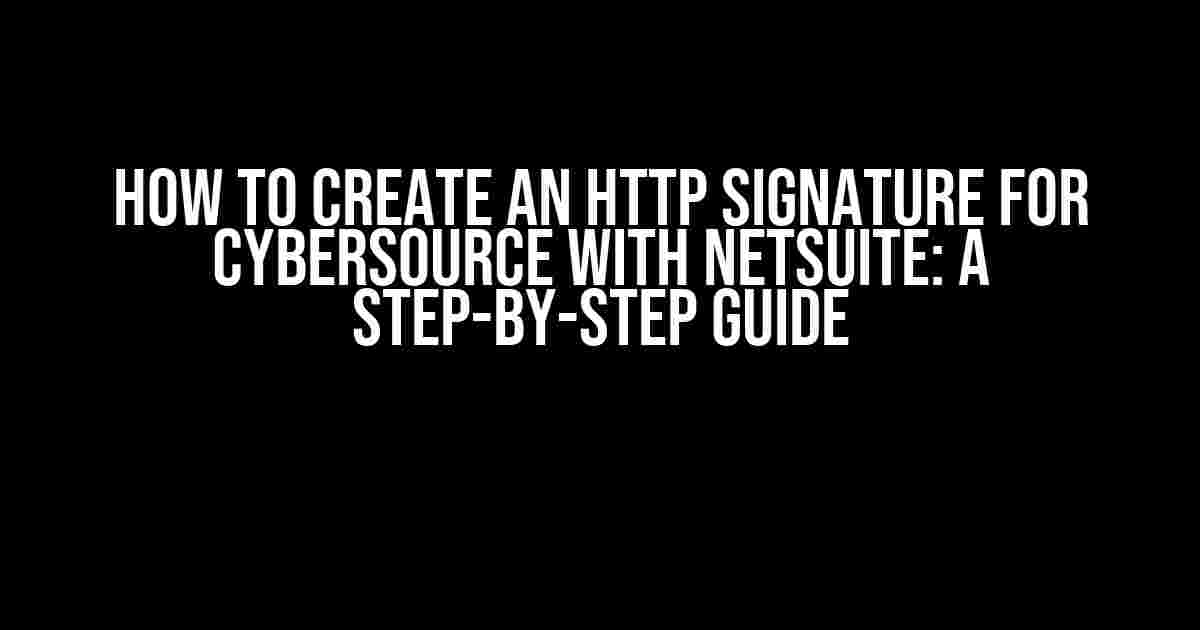Are you tired of getting rejected API requests from Cybersource due to invalid HTTP signatures? Do you want to learn how to create a valid HTTP signature for Cybersource with Netsuite? Well, you’re in luck! In this comprehensive guide, we’ll take you by the hand and walk you through the process of creating an HTTP signature that will make your API requests shine like a beacon of hope in a world of cyber transactions.
- What is an HTTP Signature?
- Why Do You Need an HTTP Signature for Cybersource with Netsuite?
- Prerequisites
- Step 1: Gather Your Keys and Secrets
- Step 2: Determine the Request Method and URI
- Step 3: Create the Signed Headers
- Step 4: Calculate the Hashed Payload
- Step 5: Create the Signature String
- Step 6: Calculate the Signature
- Step 7: Add the Signature to the Request
- Tips and Tricks
- Conclusion
What is an HTTP Signature?
An HTTP signature is a way to authenticate API requests using a cryptographic hash of the request’s headers and body. It’s like a digital fingerprint that verifies the authenticity of the request and ensures that the data hasn’t been tampered with during transit. Cybersource, being a secure payment gateway, requires a valid HTTP signature for all API requests. Without it, your requests will be rejected, and you’ll be left feeling like a failed cyber- warrior.
Why Do You Need an HTTP Signature for Cybersource with Netsuite?
When you integrate Cybersource with Netsuite, you need to ensure that your API requests are secure and trustworthy. An HTTP signature provides an additional layer of security, guaranteeing that the request comes from an authorized source and hasn’t been altered or tampered with. Without it, your sensitive payment data and customer information are at risk of being compromised.
Prerequisites
Before we dive into the step-by-step process, make sure you have the following:
- A Cybersource merchant ID and API key
- A Netsuite account with the Cybersource plugin installed
- A basic understanding of cryptography and hashing algorithms (we’ll explain it in simple terms, don’t worry!)
Step 1: Gather Your Keys and Secrets
Get your Cybersource merchant ID, API key, and shared secret from the Cybersource dashboard. These will be used to create the HTTP signature.
Merchant ID: 1234567890 API Key: abcdefghijklmnopqrstuvwxyz Shared Secret: 0123456789abcdef
Step 2: Determine the Request Method and URI
Identify the HTTP request method (GET, POST, PUT, DELETE, etc.) and the request URI. For example:
Method: POST URI: https://api.cybersource.com/v2/payments
Step 3: Create the Signed Headers
The signed headers are a list of headers that will be included in the HTTP signature. Typically, these include:
Host: api.cybersource.com Date: Wed, 21 Oct 2020 14:30:00 GMT ( request-target ): post /v2/payments
The `(request-target)` header is a special case, as it includes the request method and URI. Don’t worry about the syntax, we’ll get to that later.
Step 4: Calculate the Hashed Payload
Calculate the hashed payload using the request body and the shared secret. You can use a hashing algorithm like HMAC-SHA256. For example, if your request body is:
{
"amount": 10.99,
"currency": "USD",
"paymentMethod": "card"
}
Calculate the hashed payload using the shared secret and the request body:
hashed_payload = HMAC-SHA256(shared_secret, request_body) hashed_payload = 43e2d4a30a7c1eb9c8a15d23a35a115f
Step 5: Create the Signature String
Now it’s time to create the signature string. This is where the magic happens!
signature_string = (request-target) + "\n" +
Host + "\n" +
Date + "\n" +
"content-type: application/json" + "\n" +
"digest: SHA-256=" + hashed_payload
This string includes the signed headers, the hashed payload, and some additional information. Don’t worry about the syntax, just follow along!
Step 6: Calculate the Signature
Calculate the signature using the API key, shared secret, and the signature string. Again, you can use HMAC-SHA256:
signature = HMAC-SHA256(API_key, signature_string) signature = 0123456789abcdef
Step 7: Add the Signature to the Request
Finally, add the signature to the Authorization header of your API request:
Authorization: Signature keyId="1234567890",algorithm="hmac-sha256",signature="0123456789abcdef"
That’s it! You’ve successfully created an HTTP signature for Cybersource with Netsuite.
Tips and Tricks
Here are some additional tips to keep in mind:
- Use a secure hashing algorithm like HMAC-SHA256 or better.
- Never hardcode your API key or shared secret in your code.
- Use a secure random number generator to generate your API key and shared secret.
- Keep your API key and shared secret confidential and secure.
Conclusion
Creating an HTTP signature for Cybersource with Netsuite may seem daunting, but with these steps, you’ll be well on your way to securing your API requests. Remember to keep your API key and shared secret secure, and always use a secure hashing algorithm. Happy coding, and may the cyber forces be with you!
| Header | Example Value |
|---|---|
| Host | api.cybersource.com |
| Date | Wed, 21 Oct 2020 14:30:00 GMT |
| (request-target) | post /v2/payments |
| Content-Type | application/json |
| Digest | SHA-256=43e2d4a30a7c1eb9c8a15d23a35a115f |
Example HTTP Request:
POST /v2/payments HTTP/1.1
Host: api.cybersource.com
Date: Wed, 21 Oct 2020 14:30:00 GMT
Content-Type: application/json
Authorization: Signature keyId="1234567890",algorithm="hmac-sha256",signature="0123456789abcdef"
{
"amount": 10.99,
"currency": "USD",
"paymentMethod": "card"
}
That’s it! With this guide, you should be able to create a valid HTTP signature for Cybersource with Netsuite. Remember to follow best practices for security and keep your API key and shared secret confidential.
Here is the HTML code with 5 Questions and Answers about “How to create HTTP signature for Cybersource with Netsuite”:
Frequently Asked Questions
Get the inside scoop on creating an HTTP signature for Cybersource with Netsuite!
What is an HTTP signature and why do I need it for Cybersource with Netsuite?
An HTTP signature is a digital signature used to authenticate and verify the source of HTTP requests. You need it to ensure secure communication between Cybersource and Netsuite, verifying that the requests are coming from a trusted source. Think of it like a digital fingerprint that confirms the authenticity of your requests!
What are the required fields to create an HTTP signature for Cybersource with Netsuite?
To create an HTTP signature, you’ll need the following fields: HTTP method, request URL, request timestamp, request body, and your secret key. Make sure to keep your secret key secure, as it’s used to generate the signature!
How do I generate the signature string for Cybersource with Netsuite?
To generate the signature string, you’ll need to concatenate the required fields in the following order: HTTP method, request URL, request timestamp, and request body. Then, use your secret key to hash the concatenated string using the HMAC-SHA256 algorithm. The resulting hash is your HTTP signature!
Where do I include the HTTP signature in my request to Cybersource with Netsuite?
Include the HTTP signature in the `Authorization` header of your request to Cybersource with Netsuite. The format should be `Signature keyId=
What if I encounter issues with my HTTP signature for Cybersource with Netsuite?
If you encounter issues, double-check that your secret key is correct, and that you’re using the correct HMAC-SHA256 algorithm. Also, verify that your request timestamp is in the correct format and within the allowed timeframe. If issues persist, contact Cybersource or Netsuite support for further assistance!



